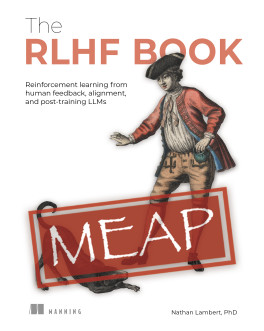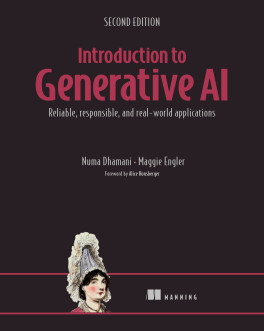pro $24.99 per month
- access to all Manning books, MEAPs, liveVideos, liveProjects, and audiobooks!
- choose one free eBook per month to keep
- exclusive 50% discount on all purchases
- renews monthly, pause or cancel renewal anytime
lite $19.99 per month
- access to all Manning books, including MEAPs!
team
5, 10 or 20 seats+ for your team - learn more

Look inside
The authoritative guide for Reinforcement learning from human feedback, alignment, and post-training LLMs.
Aligning AI models to human preferences helps them become safer, smarter, easier to use, and tuned to the exact style the creator desires. Reinforcement Learning From Human Feedback (RHLF) is the process for using human responses to a model’s output to shape its alignment, and therefore its behavior. In The RLHF Book, author Nathan Lambert blends diverse perspectives from fields like philosophy and economics with the core mathematics and computer science of RLHF to provide a practical guide you can use to apply RLHF to your models.
In The RLHF Book you’ll discover:
After ChatGPT used RLHF to become production-ready, this foundational technique exploded in popularity. In The RLHF Book, AI expert Nathan Lambert gives a true industry insider's perspective on modern RLHF training pipelines, and their trade-offs. Using hands-on experiments and mini-implementations, Nathan clearly and concisely introduces the alignment techniques that can transform a generic base model into a human-friendly tool.
Aligning AI models to human preferences helps them become safer, smarter, easier to use, and tuned to the exact style the creator desires. Reinforcement Learning From Human Feedback (RHLF) is the process for using human responses to a model’s output to shape its alignment, and therefore its behavior. In The RLHF Book, author Nathan Lambert blends diverse perspectives from fields like philosophy and economics with the core mathematics and computer science of RLHF to provide a practical guide you can use to apply RLHF to your models.
In The RLHF Book you’ll discover:
- How today’s most advanced AI models are taught from human feedback
- How large-scale preference data is collected and how to improve your data pipelines
- A comprehensive overview with derivations and implementations for the core policy-gradient methods used to train AI models with reinforcement learning (RL)
- Direct Preference Optimization (DPO), direct alignment algorithms, and simpler methods for preference finetuning
- How RLHF methods led to the current reinforcement learning from verifiable rewards (RLVR) renaissance
- Tricks used in industry to round out models, from product, character or personality training, AI feedback, and more
- How to approach evaluation and how evaluation has changed over the years
- Standard recipes for post-training combining more methods like instruction tuning with RLHF
- Behind-the-scenes stories from building open models like Llama-Instruct, Zephyr, Olmo, and Tülu
After ChatGPT used RLHF to become production-ready, this foundational technique exploded in popularity. In The RLHF Book, AI expert Nathan Lambert gives a true industry insider's perspective on modern RLHF training pipelines, and their trade-offs. Using hands-on experiments and mini-implementations, Nathan clearly and concisely introduces the alignment techniques that can transform a generic base model into a human-friendly tool.
about the book
The RLHF Book explores the ideas, established techniques and best practices of RLHF you can use to understand what it takes to align your AI models. You’ll begin with an in-depth overview of RLHF and the subject’s leading papers, before diving into the details of RLHF training. Next, you’ll discover optimization tools such as reward models, regularization, instruction tuning, direct alignment algorithms, and more. Finally, you’ll dive into advanced techniques such as constitutional AI, synthetic data, and evaluating models, along with the open questions the field is still working to answer. All together, you’ll be at the front of the line as cutting edge AI training transitions from the top AI companies and into the hands of everyone interested in AI for their business or personal use-cases.about the reader
This book is both a transition point for established engineers and AI scientists looking to get started in AI training and a platform for students trying to get a foothold in a rapidly moving industry.about the author
Nathan Lambert is the post-training lead at the Allen Institute for AI, having previously worked for HuggingFace, Deepmind, and Facebook AI. Nathan has guest lectured at Stanford, Harvard, MIT and other premier institutions, and is a frequent and popular presenter at NeurIPS and other AI conferences. He has won numerous awards in the AI space, including the “Best Theme Paper Award” at ACL and “Geekwire Innovation of the Year”. He has 8,000 citations on Google Scholar for his work in AI and writes articles on AI research that are viewed millions of times annually at the popular Substack interconnects.ai. Nathan earned a PhD in Electrical Engineering and Computer Science from University of California, Berkeley.choose your plan
team
monthly
annual
$49.99
$399.99
only $33.33 per month
- five seats for your team
- access to all Manning books, MEAPs, liveVideos, liveProjects, and audiobooks!
- choose another free product every time you renew
- choose twelve free products per year
- exclusive 50% discount on all purchases
- renews monthly, pause or cancel renewal anytime
- renews annually, pause or cancel renewal anytime
-
![]() The RLHF Book ebook for free
The RLHF Book ebook for free
choose your plan
team
monthly
annual
$49.99
$399.99
only $33.33 per month
- five seats for your team
- access to all Manning books, MEAPs, liveVideos, liveProjects, and audiobooks!
- choose another free product every time you renew
- choose twelve free products per year
- exclusive 50% discount on all purchases
- renews monthly, pause or cancel renewal anytime
- renews annually, pause or cancel renewal anytime
-
![]() The RLHF Book ebook for free
The RLHF Book ebook for free
choose your plan
team
monthly
annual
$49.99
$399.99
only $33.33 per month
- five seats for your team
- access to all Manning books, MEAPs, liveVideos, liveProjects, and audiobooks!
- choose another free product every time you renew
- choose twelve free products per year
- exclusive 50% discount on all purchases
- renews monthly, pause or cancel renewal anytime
- renews annually, pause or cancel renewal anytime
-
![]() The RLHF Book ebook for free
The RLHF Book ebook for free


















.jpg)
 The RLHF Book ebook for free
The RLHF Book ebook for free